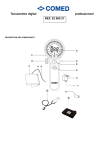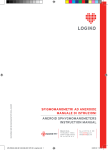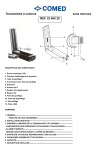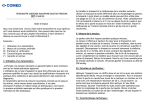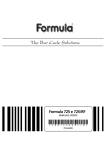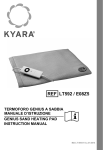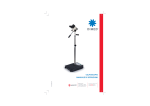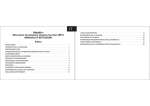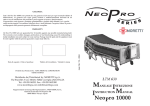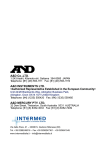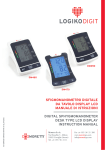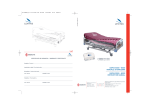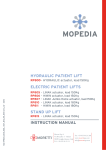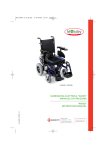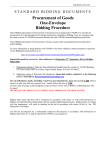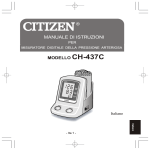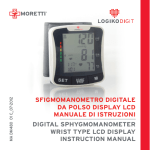Download Sfigmomanometro aD aneroiDe DigitaLe manuaLe Di iStruzioni
Transcript
MA DM325 01 A_11/2010 SfigmomanometrO AD ANEROIDE DIGITALE manuale di istruzioni Digital aneroid sphygmomanometer INSTRUCTION MANUAL Moretti S.p.A. Via Bruxelles 3 - Meleto 52022 Cavriglia (Arezzo) Tel. +39 055 96 21 11 Fax +39 055 96 21 200 www.morettispa.com [email protected] 2 Dispositivo Medico di classe I con funzioni di misura D.Lgs 24/02/97 n.46 attuazione della direttiva CEE/93/42 e successive modifiche CODICE DM325 Sfigmomanometro ad aneroide digitale INTRODUZIONE Grazie per aver scelto uno Sfigmomanometro aneroide digitale della linea LOGIKO by Moretti S.p.A. Gli sfigmomanometri ad aneroide digitale LOGIKO by Moretti S.p.A. sono stati progettati e realizzati per soddisfare tutte le vostre esigenze per un utilizzo pratico, corretto e sicuro. Questo manuale contiene dei piccoli suggerimenti per un corretto uso del dispositivo da voi scelto e dei preziosi consigli per la vostra sicurezza. Si consiglia di leggere attentamente la totalità del presente manuale prima di usare lo sfigmomanometro aneroide digitale. In caso di dubbi vi preghiamo di contattare il rivenditore, il quale saprà aiutarvi e consigliarvi correttamente. DESTINAZIONE D’USO Gli sfigmomanometri aneroidi digitali della linea LOGIKO by Moretti S.p.A. sono dispositivi per la misurazione della pressione del sangue e lavorano in modo auscultatorio secondo il metodo Riva Rocci/Korotkoff. DESCRIZIONE GENERALE Il bracciale viene avvolto intorno al braccio e gonfiato di aria grazie ad un compressore elettrico interno al dispositivo. La pressione nel bracciale viene calcolata e convertita in valori espressi in millimetri di mercurio e successivamente visualizzata da un display digitale LCD e da una serie di led che si accendono sulla scala graduata circolare. La memorizzazione dei valori di pressione da parte del dispositivo è comandata dall’utente, il quale, servendosi di un fonendoscopio (optional), dovra’ ascoltare attentamente i battiti cardiaci e al momento opportuno confermare con il pulsante “R”. I valori di pressione da misurare sono due: • Pressione massima (SISTOLICA) • Pressione minima (DIASTOLICA) La pressione SISTOLICA è il valore di pressione nel momento in cui sono percepibili chiaramente almeno due battiti consecutivi del cuore, mentre nel momento in cui gli stessi battiti cessano di essere riconoscibili si ottiene la pressione DIASTOLICA. CHE COSA E’ LA PRESSIONE DEL SANGUE? La pressione sanguigna è la pressione esercitata dal sangue sulle pareti dei vasi sanguigni. La pressione massima nelle arterie durante il ciclo cardiaco è definita come pressione SISTOLICA, mentre la pressione più bassa è definita come pressione DIASTOLICA. QUAL’È UNA NORMALE PRESSIONE DEL SANGUE? é necessario sapere che la pressione arteriosa è sottoposta a forti fluttuazioni. Il livello della pressione arteriosa dipende da molti fattori. Generalmente la pressione arteriosa è più bassa in estate e più alta in inverno. La pressione arteriosa può variare con la pressione atmosferica, ed è notevolmente influenzata ad esempio da carichi fisici, eccitabilità emotiva, stress, pasti, medicinali, alcool, fumo, età ecc ... Si raccomanda di scrivere le misurazioni quotidiane, in modo tale da consultare un medico per definire in modo appropriato un valore di pressione normale per il proprio organismo. N.B. La pressione del sangue varia con l’eta’, quindi è necessario consultare il medico per definire una pressione normale per voi. In nessun caso dovrete modificare il dosaggio di eventuali farmaci prescritti dal medico! NORME E DIRETTIVE DI RIFERIMENTO Gli sfigmomanometri ad aneroide digitale LOGIKO by Moretti S.p.A. sono costruiti in conformità alla vigente norma EN 1060-1-3: EN 1060-1 Sfigmomanometri non invasivi, requisiti generali; EN 1060-3Sfigmomanometri non invasivi, requisiti supplementari per Sfigmomanometri elettromeccanici. AVVERTENZE PER L’UTILIZZO Per un utilizzo corretto del dispositivo fare riferimento attentamente al presente manuale. Seguire sempre le indicazioni riguardanti il prodotto da voi acquistato. Tenere il dispositivo sempre lontano dalla portata dei bambini. 3 VISTA E DESCRIZIONE DELLE PARTI 1. Corpo principale del dispositivo 2. Display LCD 3. Tubo di collegamento del bracciale 4. Connessione uscita aria 5. Bracciale 6. D-ring del bracciale (anello) 7. Adattatore di alimentazione AC 8. Bottone “R” per memorizzare 9. Bottone START per accendere/spegnere e gonfiare 10. Valvola regolazione deflusso aria 11. Batteria ricaricabile li-ion MONTAGGIO GENERALE DELLE PARTI Questo dispositivo funziona tramite batterie ricaricabili oppure con l’alimentatore in dotazione. Anche se le batterie non sono installate il dispositivo puo’ funzionare con l’adattatore di alimentazione esterno. Collegare il tubo del bracciale al relativo connettore sul dispositivo. N.B. La batteria non è carica quando acquistate il dispositivo. Collegare il dispositivo all’adattatore AC e caricare la batteria per piu’ di 4 ore prima dell’uso. - Si prega di ricaricare la batteria con l’adattatore quando sul display del dispositivo lampeggia l’indicazione di batteria scarica. - Quando l’adattatore è connesso la batteria si ricaricherà automaticamente.Allo stesso tempo il display LCD mostrerà l’immagine delle batterie in ricarica. - Una volta che la batteria sara’ completamente carica sul display apparirà. SOSTITUZIONE DELLA BATTERIA Il dispositivo può fornire circa 200 cicli di misurazione con batterie completamente cariche. Approssimativamente la vita delle batterie ricaricabili è di circa 2 anni e quando l’icona appare continuamente sul display si consiglia di sostituire la batteria con una nuova. • Aprire il coperchio di chiusura posteriore e installare la batteria ricaricabile specificata nel comparto porta batteria facendo attenzione alla corretta polarità. • Chiudere il coperchio del comparto batterie. Non usare batterie o adattatori non specifici per questo dispositivo! MODALITÁ D’USO L’utente si dovrebbe trovare in un ambiente caldo. I capi di vestiario dovrebbero essere rimossi dal braccio sinistro. Sedersi ad un tavolo o una scrivania, dove si può facilmente distendere il braccio. Posizionare il gomito sul tavolo in modo che si trovi all’incirca alla stessa altezza del cuore. Posizionare il palmo della mano rivolto verso l’alto. 4 Avvolgere il bracciale intorno al braccio nudo in modo che il centro del bracciale corrisponda all’arteria brachiale. La parte inferiore del bracciale deve trovarsi a circa 2-3 cm di distanza sopra la piega del gomito. Stringere il bracciale in modo da renderlo aderente al braccio. Si deve poter inserire ancora un dito fra il bracciale e il braccio. N.B. Non stringere eccessivamente altrimenti si ridurrà sensibilmente la circolazione del flusso sanguigno. Inserire la testa del fonendoscopio (optional) sotto al centro del bracciale, ad una distanza dalla piegatura del gomito di circa 3-4 cm. N.B. Il fonendoscopio non deve essere premuto troppo saldamente al bracciale altrimenti la pressione Diastolica misurata risulterà falsata. Procedere con la misurazione nel seguente modo • Indossare l’archetto del fonendoscopio per ascoltare i battiti cardiaci. • Premere il pulsante START per accendere il dispositivo. Per un attimo si accenderanno tutti i simboli presenti sul display (fig.1) e verrà visualizzata la pressione residua all’interno del bracciale (normalmente deve essere = 0 mmHg). Se la pressione è uguale a circa “0 mmHg” lampeggierà una freccia rivolta verso l’alto ad indicare che l’utente deve avviare la procedura di gonfiaggio del bracciale (fig.2), altrimenti lampeggierà una freccia rivolta in basso ad indicare all’utente di aprire la valvola di deflusso aria per riportare la pressione a “0 mmHg “(fig.3). • Chiudere completamente la valvola di deflusso aria. • Premere e mantenere premuto il pulsante START per attivare il compressore ad aria interno al dispositivo. • Gonfiare il bracciale fino ad una pressione di circa 40 mmHg superiore alla normale pressione sistolica. Se non si conosce la normale pressione sistolica del nostro corpo allora procedere al gonfiaggio fino ad una pressione di circa 180 mmHg (fig.4). N.B. Se questa pressione non è sufficiente per la misurazione, gonfiare ulteriormente il bracciale. • Raggiunta la pressione desiderata rilasciare il pulsante START. • Svitare la valvola di deflusso aria in modo da ottenere un calo di pressione costante di circa 2-3 mmHg al secondo. • Sul display lampeggiera’ l’indicazione “ SYS “ ad indicare all’utente di ascoltare attentamente i battiti cardiaci per rilevare la pressione massima (SISTOLICA) (fig.5). N.B. La pressione SISTOLICA è il valore di pressione nel momento in cui sono percepibili chiaramente almeno due battiti consecutivi del cuore. • Premere il pulsante “ R” per memorizzare la pressione sistolica. •Sul display a questo punto lampeggierà l’indicazione “ DIA “ ad indicare all’utente di ascoltare attentamente i battiti cardiaci per rilevare la pressione minima (DIASTOLICA) (fig.6). N.B. La pressione DIASTOLICA è il valore di pressione nel momento in cui non sono piu’ chiaramente percepibili i battiti del cuore. • Premere il pulsante “ R “ per memorizzare la pressione diastolica. • A questo punto la misurazione è terminata e sul display compare la freccia rivolta in basso ad indicare di scaricare tutta la pressione residua all’interno del bracciale svitando completamente la valvola di deflusso aria (fig.7). • Sul display a questo punto verranno visualizzate alternativamente la pressione SISTOLICA e quella DIASTOLICA. 5 Inoltre lampeggierà sempre anche la freccia rivolta verso l’alto ad indicare che il dispositivo è pronto per un ulteriore misurazione (fig.8). N.B. se ad esempio durante la fase di misurazione la pressione SISTOLICA viene memorizzata regolarmente e la pressione DIASTOLICA non viene memorizzata alla fine della misurazione sul display al posto della pressione DIA verra’ indicato una serie di trattini “- - -” ALLARME DI ERRORE Quando la differenza tra la pressione diastolica e quella sistolica è meno di 8 mmHg, 4 brevi “beep” suoneranno e sul display apparirà per un secondo l’indicazione “Err” (fig. 9). In questo caso la pressione diastolica sara’ rimossa dalla memoria e si dovrà procedere a registrarla ancora. fig. 9 RAPIDO SGONFIAGGIO DURANTE LA MISURAZIONE Se l’utente non si sente bene durante la misurazione oppure quando si vuole fermare la misurazione per qualche motivo, si può svitare completamente la valvola di deflusso aria e quindi la pressione tenderà a scendere velocemente a zero. AUTOSPEGNIMENTO Se il dispositivo rimane inutilizzato per piu’ di un minuto e allo stesso tempo la pressione di aria nel bracciale è inferiore a 10 mmHg il dispositivo si spegnera’ automaticamente. Se invece la pressione di aria è superiore a 10 mmHg allora suonera’ un “beep” per ricordare all’utente di sgonfiare completamente il bracciale , quindi il dispositivo si spegnera’ automaticamente. AVVERTENZE PER LA MISURAZIONE DELLA PRESSIONE SANGUIGNA • Normalmente utilizzare sempre il braccio sinistro. • Il braccio deve essere scoperto senza indumenti sopra. • Evitare qualsiasi attivita’ prima della misurazione. • Rimanere a riposo dai 5 ai 10 minuti prima di misurarsi la pressione del sangue. • Non parlare, mangiare, bere o muoversi durante la fase di misurazione. • Non premere la testa del fonendoscopio con le dita. Questo potrebbe interferire con la lettura della pressione sanguigna. • Fare le misurazioni della pressione sempre alle stesse ore. • Annotare sempre la data e l’ora della misurazione. 6 SOLUZIONE PROBLEMI SINTOMO Il display non si accende quando si preme il bottone START CAUSA RIMEDIO Le batterie sono scariche. Ricaricare le batterie con l’alimentatore incluso oppure sostituire le batterie. La polarità delle batterie è sbagliata. I contatti delle batterie all’interno del comparto porta batterie sono sporchi. Installare le batterie con la polarita’ corretta. Pulire i contatti del porta batterie con un panno asciutto. Il bracciale si trova alla stessa altezza del cuore? Fare attenzione alla corretta postura durante la misurazione. Il bracciale è allacciato correttamente? Allacciare il bracciale correttamente. Il vostro braccio era in tensione durante la misurazione? Rilassatevi durante la misurazione. Avete parlato oppure mosso il braccio o la mano durante la misurazione? Rimanete in silenzio e fermi durante la misurazione. Le batterie si scaricano spesso Vengono utilizzate batterie non idonee. Utilizzare solo batterie ricaricabili raccomandate in questo manuale. Il dispositivo si è spento automaticamente E’ entrato in funzione lo spegnimento automatico del sistema. Questa funzione serve per il risparmio energetico e non è da considerare come un difetto del dispositivo. La lettura è estremamente bassa oppure alta MANUTENZIONE E CURA I dispositivi della linea LOGIKO by Moretti S.p.A. al momento dell’immissione in commercio sono controllati accuratamente e provvisti di marchio CE. Ogni sfigmomanometro viene calibrato e sottoposto ad un controllo finale completo al 100%. Consultare il proprio rivenditore per un’ assistenza tecnica qualificata. In caso di riparazione devono essere utilizzati soltanto ricambi ed accessori originali. PRESTARE MOLTA ATTENZIONE AI SEGUENTI FATTORI •E’ necessario proteggere il dispositivo dai raggi diretti del sole, dall’umidità, da urti, da alcool, solventi e benzine. •Rimuovere le batterie se il dispositivo rimane inutilizzato per lungo tempo e tenere le batterie lontane da bambini. •Non cercare di estendere o arrotolare il bracciale. •Per pulire il dispositivo usare esclusivamente un panno morbido ed asciutto. •Potete pulire il bracciale con un panno umido come manutenzione giornaliera. •Per evitare di contrarre infezioni quando si deve condividere il bracciale si può eseguire un trattamento sanificante del lato a contatto con il braccio utilizzando del cotone inumidito con una soluzione al 3% di diossido di idrogeno. Dopo un lungo utilizzo è normale andare incontro ad un leggero scolorimento del bracciale. •Non e’consentito lavare il bracciale in lavatrice, come non é consentito stirarlo con il ferro da stiro. ATTENZIONE: Per nessun motivo dovete lavare la camera d’aria interna al bracciale. •Non aprire il dispositivo. Esso é costituito da un insieme molto complesso e delicato di componenti elettronici e unità ad aria che potrebbero essere danneggiate. •Se non riuscite ad eliminare il problema usando la sezione inerente alla soluzione problemi dovrete rivolgervi al vostro rivenditore. E’ generalmente raccomandato far controllare il dispositivo almeno ogni due anni per essere sicuri della funzionalità e precisione. AVVERTENZE GENERALI E’ vietato l’utilizzo del seguente prodotto per fini diversi da quanto definito nel seguente manuale. La MORETTI S.p.A. declina qualsiasi responsabilità su danni provocati da un uso improprio del dispositivo o da un uso diverso da quanto indicato nel presente manuale. 7 Il produttore si riserva il diritto di apportare modifiche al dispositivo e al seguente manuale senza preavviso allo scopo di migliorarne le caratteristiche. CONDIZIONI DI SMALTIMENTO AVVERTENZE PER IL CORRETTO SMALTIMENTO DEL PRODOTTO AI SENSI DELLA DIRETTIVA EUROPEA 2002/96/EC: Alla fine della sua vita utile il prodotto non deve essere smaltito insieme ai rifiuti urbani. Può essere consegnato presso gli appositi centri di raccolta differenziata predisposti dalle amministrazioni comunali, oppure presso i rivenditori che forniscono questo servizio. Smaltire separatamente il prodotto consente di evitare possibili conseguenze negative per l’ambiente e per la salute derivanti da un suo smaltimento inadeguato e permette di recuperare i materiali di cui è composto al fine di ottenere un importante risparmio di energie e di risorse. Per rimarcare l’obbligo di smaltire separatamente le apparecchiature elettromedicali, sul prodotto è riportato il marchio del contenitore di spazzatura mobile sbarrato. TRATTAMENTO DELLE BATTERIE ESAUSTE - (Direttiva 2006/66/CE) Questo simbolo sul prodotto indica che le batterie non devono essere considerate come un normale rifiuto domestico. Assicurandovi che le batterie siano smaltite correttamente contribuisce a prevenire potenziali conseguenze negative per l’ambiente e per la salute che potrebbero altrimenti essere causate dal loro inadeguato smaltimento. Il riciclaggio dei materiali aiuta a conservare le risorse naturali. Conferire le batterie esauste presso i punti di raccolta indicati per il riciclo. Per in formazioni più dettagliate circa lo smaltimento delle batterie esauste o del prodotto potete contattare il Comune, il servizio locale di smaltimento rifiuti oppure il negozio dove avete acquistato l’apparecchio. CARATTERISTICHE TECNICHE DISPOSITIVO - DIMENSIONI 174(L)x70.5(P)x40(H)mm - PESO circa 199 g con le batterie montate - METODO DI MISURAZIONE Riva Rocci /Korotkoff - CAMPO DI MISURA da 40 a 260 mmHg (pressione del sangue) - PRECISIONE +/- 3 mmHg per la pressione sistolica e diastolica - GONFIAGGIO automatico tramite compressione interno - SGONFIAMENTO RAPIDO manuale - TEMPERATURA E UMIDITA’ OPERATIVA da +10°C a + 40°C , 85% max - TEMPERATURA E UMIDITA’ DI IMAGAZZINAGGIO da -20°C a +50°C , 85% max - DIMENSIONE DEL BRACCIALE applicabile su un braccio di circonferenza tra 22 e 32cm ADATTATORE AC - USCITA IN TENSIONE - CORRENTE MAX IN USCITA - POLARITA’DEL CONNETTORE 5Vdc +-5% 1000mA + internamente BATTERIE - TENSIONE - CAPACITA’ - MODELLO 3.7V 650 mAh ICR123A Li-ion RICARICABILI PARTI DI RICAMBIO/ACCESSORI Per le parti di ricambio e gli accessori consultare il catalogo generale MORETTI S.p.A. 8 GAranzia Il prodotto è garantito 2 ANNI dalla data di acquisto. Il distributore si riserva il diritto di riparare o sostituire le parti affette da difetti di fabbricazione o nei materiali usati, senza nessuna spesa per il cliente. La garanzia non è applicabile in caso di danni legati ad un uso improprio, ad abusi, ad alterazioni o ad uno smontaggio effettuato da personale non autorizzato. Per riparazioni, nel rispetto delle suddette condizioni per l’esercizio della garanzia, inviare il prodotto munito della ricevuta di acquisto al rivenditore locale più vicino. CERTIFICATO DI GARANZIA Prodotto_________________________________________________________________________________________________________________________ Acquistato in data___________________________________________________________________________________________________________ Rivenditore_____________________________________________________________________________________________________________________ Via Località _____________________________________________________________________________________________________________________________________ Venduto a _____________________________________________________________________________________________________________________________________ Via Località _____________________________________________________________________________________________________________________________________ 90° Nantong Little Doctor Electronic CO., Ltd - No.8, Tongxing Road, Economic & Technical - 226010 Nantong City, Jiangsu - CHINA EC REP SHANGHAI INTERNATIONAL TRADING CORP. GMBH Eiffestrasse 80, 20537 Hamburg, Germany Distribuito da / Distributed by: Moretti S.p.a. Via Bruxelles, 3 - Meleto 52022 Cavriglia (Arezzo) Tel. +39 055 96 21 11 www.morettispa.com email: [email protected] MADE in P.R.C. 9 Class I Medical Device with measuring function according to Directive EEC 93/42 and subsequent amendments CODE DM325 Digital aneroid sphygmomanometer INTRODUCTION Thank you for having chosen a LOGIKO aneroid sphygmomanometer by Moretti. The LOGIKO sphygmomanometers by Moretti S.p.A. are designed and built to meet all your demands for safe, practical, correct use. This manual provides some suggestions like how to correctly use the device you have chosen and gives some valuable advice for your safety. Please read through the manual carefully before using the aneroid sphygmomanometer. Contact your retailer directly for questions or further assistance. INTENDED PURPOSE The LOGIKO aneroid sphygmomanometers by Moretti S.p.A. are devices used to measure blood pressure. They are based on the auscultatory technique according to the Riva Rocci/Korotkoff method. GENERAL DESCRIPTION The air pressure within the cuff needed to take the measurement is created by an electric pump inside the device. The air pressure in the cuff is calculated and converted into mmHg (millimetres of mercury) and it is displayed on the LCD graduated scale. The storage of the measurements has to be confirmed by the user with the aid of a stethoscope (optional). The user has to listen to the heart rate carefully and confirm the right rate pressing the button “R”. Two values have to be measured: • Maximum arterial pressure (SYSTOLIC) • Lowest arterial pressure (DIASTOLIC) When you can clearly perceive at least two consecutive heartbeats, this is your peak SYSTOLIC pressure. When these beats cease being recognisable, you have your lowest DIASTOLIC pressure. WHAT IS BLOOD PRESSURE ? Blood pressure is the pressure exercised by the blood on the blood vessel walls. The maximum arterial pressure during the cardiac cycle is defined as SYSTOLIC pressure. The lowest arterial pressure is defined as DIASTOLIC pressure. WHAT IS NORMAL BLOOD PRESSURE ? Blood pressure can vary greatly because it depends on a great many factors. Generally speaking, blood pressure is lower in the summer and higher in the winter. Blood pressure can vary with atmospheric pressure and is significantly affected, for example, by physical demands, emotions, stress, meals, medicines, alcohol, smoke, age, etc.. It is a good idea to write down daily measurements and then consult a doctor in order to suitably define a normal blood pressure for your own body. Note - Blood pressure varies with age, you will therefore need to consult a doctor to find out what blood pressure is normal for you. Under no circumstances should you alter the dosage of any drugs your doctor may have prescribed! REGULATIONS AND DIRECTIVES OF REFERENCE The LOGIKO sphygmomanometers by Moretti are built in compliance with current standard EN 1060-1-3: EN 1060-1 Non-invasive sphygmomanometers, general requirements; EN 1060-3 Non-invasive sphygmomanometers, supplementary requirements for digital sphygmomanometers. WARNINGS FOR USE Please read carefully this manual to ensure correct use of the device. Always follow the instructions given with regard to the product you have purchased. Always keep the device out of the reach of children. 10 DESCRIPTION OF PARTS 1. Main body 2. LCD 3. Air hose 4. Air connector 5. Cuff 6. D-ring 7. AC power adapter 8. Record button 9. Start button 10. Deflativo valve 11. Li-ion rechargeable battery GENERAL PARTS ASSEMBLING This device only works with rechargeable battery or with its adapter. Even if the battery is not installed the device can still work with the external adapter. Connect the air connector to the device. Note - Note-the battery is not charged when you purchase the device. Connect the device to AC adapter to charge the new battery for more than 4 hours before use. - Please charge the battery with the adapter when there is low battery indication flashing. - When the adapter is connected, the adapter will charge the installed rechargeable battery automatically. At the same time the LCD will show pictures of battery in charge. - Once the battery is fully charged (picture) will show in the LCD BATTERY REPLACEMENT The device can provide at least 200 times measurement with battery fully charged. Approximate life for the rechargeable battery is 2 years, and when the icon appears frequently even you charge it timely, please change the rechargeable battery with new one. •Open the battery cover and install the rechargeable battery specified into the battery compartment as indicated. Make sure that the polarity is correct •Close the battery compartment cover. Don’t use any battery not specific for the device! DIRECTIONS FOR USE The subject should be in warm environment. Tight or restrictive clothing should be removed from the arm. The subject should sit at the table or desk where the subject can easily rest his/her arm. Wrap the cuff around the subject’s naked arm so the arterial mark is just over the brachial artery pulse. Position the cuff approximately 2-3 cm above the elbow and slip the top part of the cuff. The cuff should be snug, not be too tight. Two fingers should be easily put in between cuff and arm. The cuff should be not about the same level as the subject’s heart. 11 Note - Not over-tighten the cuff or you will significantly reduce the circulation of blood flow Place the head of the sthetoscope just over the humerus artery of the armpit. Note - The stethoscope must not be pressed too firmly to the cuff, otherwise the diastolic pressure may be underestimate. PROCEED WITH MEASUREMENT IN THIS WAY • Gently place the stethoscope’s ear pieces in your ears. • Press START button, and all symbols will appear on display as Fig.1 and the residual pressure inside the cuff (normally should be =0 mmHg). If the pressure will be almost like “0 mmHg” an upward arrow flashes to remind the user to inflate as Fig.2. Otherwise the display will show downward arrow to remind the user to deflate the air in the cuff as Fig.3. Please unscrew the deflation valve to deflate the air until “0 mmHg” and upward arrow appears. • Close completely the deflation valve. • Press and hold START button to inflate the pressure to about 40 mmHg above the subject’s regular systolic pressure, it you dont know the normal pressure of your body just pump up to about 180 mmHg as Fig.4. Note- if you find the inflate pressure is not enough, please hold on START button to re-inflate. • Release Start button once you reach the desidered pressure. • Unscrew the deflation valve for a deflation of 2-3 mmHg per second. • The “SYS” will flash in the LCD as Fig.5 to remind you to listen carefully and record the systolic pressure. Note - When you can clearly perceive at least two consecutive heartbeats, this is your peak (SYSTOLIC) pressure. • Press “R” button to record systolic pressure • On display will flash “DIA” to remind you to get ready to record the diastolic pressure (Fig.6). When you hear the diastolic pressure, just press RECORD to record the diastolic pressure. Note - When these beats cease being recognisable, you have your lowest (DIASTOLIC) pressure. • • The measurement is now finished and the downward arrow flashes in the LCD to remind you unscrewing the deflation valve for rapid deflation (Fig.7). Unscrew the deflation valve for rapid deflation, and the systolic pressure and diastolic pressure will flash in the LCD alternately. At the same time, the upward arrow will flash to remind you that the device is ready for another measurement (Fig.8). Note - You record only systolic pressure without recording the diastolic pressure in the LCD will appear a series of dashes “---“ 12 fig. 9 ERROR ALARM When the difference between diastolic pressure recorded and systolic pressure recorded is less than 8 mmHg, 4 short beeps will sound and “Err” will appear in the LCD for 1 second (Fig.9). In this case, the diastolic pressure recorder will be deleted, and you have to record the diastolic pressure again. RAPID DEFLATION DURING MEASUREMENT If the subject not feel well during measurement or you want to stop the measurement for some reason, you can unscrew the deflation valve. AUTOMATIC TURNING OFF If you do not use the device for more than 1 minute and the air pressure in the cuff is less than 10mmHg, the device will turn off automatically. If the air pressure is more than 10mmHg the device will beep to remind you to deflate the cuff. After deflating it will turn off automatically. WARNINGS FOR MEASURING BLOOD PRESSURE • Generally speaking, you should always use the left arm. • Uncover your arm, remove all clothing from it. • Avoid all activity prior to taking the measurement. • Rest for 5 to 10 minutes prior to measuring blood pressure. • Do not talk, eat, drink or move whilst taking your blood pressure. • Do not press the head of the stethoscope with your fingers. This could affect the blood pressure reading. • Always measure blood pressure at the same time. • Always record the time and date of measurement. 13 PROBLEM SHOOTING SYMPTOM CAUSE REMEDY The battery have run down. No display when the START button is pressed The polarity of battery is wrong Charge the battery with the adapter or replace the battery with new one The contact of battery compartment is polluted Install the battery correctly Clean the battery terminals with dry cloth Is the cuff at the same level as the heart? Make sure that your posture is right The reading is extremely low or high Is the cuff wrapped right? Wrap the cuff correctly Did you strain your arm during measurement Relax during measurement Did you talk or move your arm (or hand) during measurement? Keep quiet and silent during the measurement The battery are run down Faulty batteries are used Use only rechargeable battery in the manual The device is automatically turned off It is the result of automatically turn off system This is to save the power consumption of the device, and it is not a fault MAINTENANCE AND CARE LOGIKO by Moretti S.p.A. devices have been thoroughly checked before market introduction and provided with CE mark. Each sphygmomanometer is calibrated and treated to a complete exam. Please consult your seller for a specific technical assistance. In case of repair please use only original spare parts. WARNING • It is necessary to protect this device against high moisture, direct sunlight, shock, solvent, alcohol and gasoline. • Remove the battery if the device is to be stored for a long time, and keep the battery far from the children. • Keep the cuff from sharp subject and don’t extend or twist the cuff. • Use only soft and dry cloth to clean the device. • The cuff is sensitive and must be handled with care. You can clean the cuff cover with damp cloth as daily maintenance. • To avoid across infection when share the cuff, you can apply sanitary treatment to the inner side of fabrics cover of the cuff and contacting with help of cotton wool tampons, moistened by 3% solution of hydrogen dioxide. After using, it is allowed partial discoloration of fabrics covering of the cuff. It is not allowed the laundry of the cuff, as well as ironing by hot flatiron. • Is not allowed to wash the cuff in washing machine, or iron it. ATTENTION: under no circumstances may you wash the inner bladder! •Do not open the device it has complex and delicate electrical components and air-units which could be damaged. •If you cannot fix the problem using the trouble table instruction, request service from your dealer. It is recommended to make a control on the device every two years to be ensure that the device is correctly working. GENERAL WARNINGS Do not use the following product for purposes other than that defined by this manual. MORETTI S.p.A. refuses all liability for damages caused by improper use of the device or by its use for a purpose other than that specified in this manual. The manufacturer reserves the right to make changes to the device and this manual in order to improve the device characteristics without advance notice. DISPOSAL CONDITION Do not dispose the product together with urban waste. It can be handed over to the applicable collection points for the recycling of waste batteries or to the retailers offering this service. A separate disposal of the product can avoid after-effects for the environment and health and it allows to recycle the material and to save energy and resources. To focus on the obligation of disposing electromedical devices you will find the WEEE symbol on the product. TREATMENT OF FLAT BATTERIES (Directive EEC 2006/66) Batteries are hazardous waste. Do not dispose them together with house-hold garbage. At the end of their life hand the batteries over to the applicable collection points for the recycling of waste batteries. For more detailed information about 14 recycling of this product or battery, please contact your local Civic Office, or the shop where you purchased the product. TECHNICAL FEATURES - Size - Weight - Measuring method - Measuring range - Measuring accuracy - Inflation - Rapid deflation - Operation temperature and humidity - Storage temperature and humidity - Cuff size AC ADAPTOR - Output voltage - Max output current - Connector polarity BATTERY - Voltage - Capacity - Model 174(L)x70.5(W)x40(H) mm Around 199g with battery Riva Rocci/ Korotkofff 40 to 260 mmHg (blood pressure) +/- 3 mmHg for systolic and diastolic pressure Automatic by pump Manual +10°C to +40°C, 85% -20°C to +50°C, 855 Applicable for arm size 22-32cm 5Vdc +-5% 1000 mA + internaL 3.7V 650 mAh ICR123A Li-ion rechargeable SPARE PARTS/ACCESSORIES For spare parts and accessories consult the general catalogue Moretti S.p.A 15 WARRANTY The product has 2-year warranty from purchase date which is certified by the receipt or invoice. The distributor reserves the right either to repair or replace necessary parts to correct defects in the materials or workmanship without any charge. The warranty does not apply to damage resulting from failure to follow the operating instructions, accidents, abuse, alteration or disassembly by unauthorized individuals. In case you need to get the product repaired and you fulfil the conditions of warranty, send it to the nearest retailer together with the purchase receipt. WARRANTY CERTIFICATE Product________________________________________________________________________________________________________________________ Purchasing date____________________________________________________________________________________________________________ Authorized dealer _________________________________________________________________________________________________________ Street Place ____________________________________________________________________________________________________________________________________ Sold to ____________________________________________________________________________________________________________________________________ Street Place ____________________________________________________________________________________________________________________________________ 90° Nantong Little Doctor Electronic CO., Ltd - No.8, Tongxing Road, Economic & Technical - 226010 Nantong City, Jiangsu - CHINA EC REP SHANGHAI INTERNATIONAL TRADING CORP. GMBH Eiffestrasse 80, 20537 Hamburg, Germany Distribuito da / Distributed by: Moretti S.p.a. Via Bruxelles, 3 - Meleto 52022 Cavriglia (Arezzo) Tel. +39 055 96 21 11 www.morettispa.com email: [email protected] MADE in P.R.C.
















